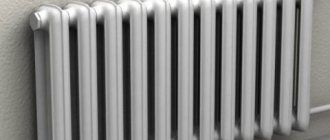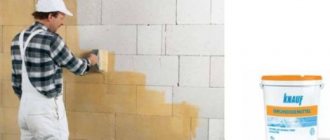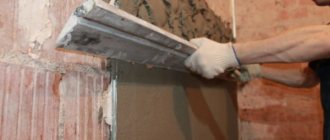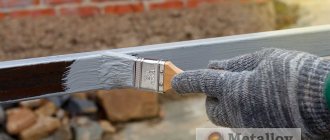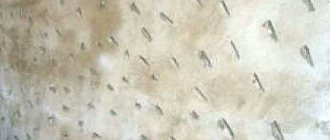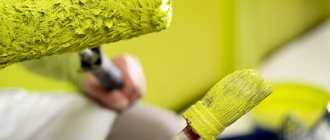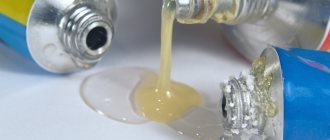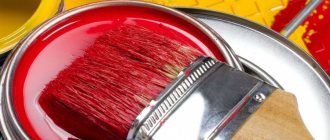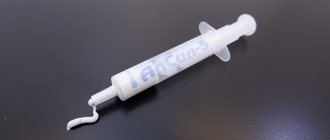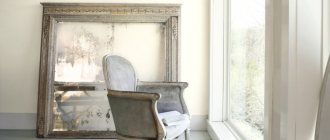Properties and functions of water-repellent primer
The primer is an opaque mass with a liquid consistency. Upon contact with the surface, it penetrates deep into the base. After which a moisture-repellent film appears. It represents a protective barrier.
The composition is most often used to treat concrete surfaces in the bathroom or kitchen. It is used in rooms with high humidity or for facade work. In addition to stone and concrete, soil can be used for other surfaces - wood, plasterboard sheets, plastic.
With the help of the substance, it is possible to avoid the destruction of the coating, which is exposed to constant exposure to water. The unique characteristics of the soil are important when performing the following types of work:
- laying tiles in the bathroom or kitchen;
- finishing of building facades;
- room decoration;
- the need to apply paints and varnishes.
Preparatory work
First you need to prepare the walls for painting. In other words, it is necessary to remove the previous layer. Most often, this is either old tiles or paint.
You can remove and clean both of them yourself. You can remove paint from the walls using a regular spatula. If the old epoxy paint adheres well to the wall and does not come off, then you can leave it and proceed to the next step.
The next step will be putty. It is best to use moisture-resistant ones, because the climate in the bathroom requires high humidity. The ideal option would be latex water-emulsion dispersed putty.
It is specially designed for interior work and waterproof finishing of a room.
According to all the rules, you need to putty from the bottom up. First, it needs to be applied to the uneven walls, so they can be partially leveled.
The third preparatory stage will be primer . For the bathroom, it is advisable to use a special moisture-proofing primer. Do-it-yourself decorative painting of bathroom walls?
Which soil to choose is up to you; in general, they are universal.
Paint for walls in the bathroom must be special - resistant to high humidity, so carefully read the instructions on the can before purchasing or consult with the store manager.
Painting should begin no earlier than 24 hours from the moment the primer is applied; it must dry completely.
Prices for acrylic paint (Tikkurila, Dulux, etc.) are quite affordable and will be affordable for anyone. You can choose the color right in the store. How much the primer costs depends on the region where you live, but in general its cost varies around 150-200 rubles per bottle.
Pros and cons of using soil for wet areas
The use of a hydrophobic primer has the following advantages:
- Increased adhesion between finishing layers. This property is of particular importance if the bathroom or toilet has uneven walls or floors. In such a situation, a thick layer of leveling materials will be required to obtain a flawless surface.
- Protection from moisture. This treatment helps to reduce the water absorption parameters of the surface. This helps normalize the indoor microclimate.
- Reduced levels of dusting and vulnerability to chemical elements. This effect is observed in the case of applying primer to a concrete floor without subsequent finishing.
- Increased overall structural stability. This is due to strengthening with polymer complexes.
At the same time, using a primer for wet rooms also has a number of disadvantages. The main disadvantages include the following:
- The complexity of the process. Applying primer yourself takes a lot of time and effort. This entails an increase in the cost of work.
- Vapor permeability of some compositions after polymerization. As a result, humidity parameters increase. To get rid of excess moisture, it is necessary to organize forced ventilation.
- High cost of imported compounds. If you want to save money, it is better to give preference to domestic soils.
Types of water repellents and their characteristics
Today there are quite a lot of effective products on sale, which differ in composition and properties. This helps you choose the best option based on your goals and objectives.
Organic
The basis of organic mixtures are acrylic and epoxy compounds. Polyurethane is also used for their production. Such substances fill the pores and promote the combination of cement dust. This makes the coating more durable. The main advantages of organic substances include the following:
- high degree of strength;
- low moisture permeability;
- almost complete absence of shrinkage;
- no pungent odor upon application;
- resistance to the influence of mechanical factors;
- Decorative – this primer gives the coating a shiny texture.
See also
Technical characteristics of AK-070 soil, pros and cons and how to use
Inorganic
Among the variety of inorganic primers, acrylic ones are considered the most popular. They have the most affordable price. However, such compositions cannot be called durable. After 2-3 years they need to be applied again.
Inorganic types of soil are characterized by the following properties:
- increasing the protective properties of concrete surfaces from the influence of aggressive factors;
- preventing the appearance of concrete dust.
Concrete contact
This substance provides excellent contact between paint and varnish materials and the surface being treated. To make this type of primer, acrylic dispersion and filler are used. Its functions are performed by cement and quartz sand.
Bitumen primers
This substance is ready for use. Unlike conventional bitumen, the composition does not need to be heated. Before use, the mass should be mixed thoroughly. It is convenient and easy to apply. The “liquid glass” solution is as close as possible to foam-forming compositions. It is mainly used for treating the walls and bottom of swimming pools.
Deep penetration soils
Such products are usually produced on the basis of acrylic resins. Particles of such compositions can reach a surface depth of up to 2 centimeters.
Polyurethane
This soil is considered universal. It can be used for almost all substrates with different levels of porosity and absorbent properties. The substance is equally convenient to use on concrete surfaces and wood.
The primer can be used for exterior and interior use, and is considered quite durable. The main disadvantage is the long drying period.
Recommendations for selection
To choose a high-quality waterproofing composition, it is worth taking into account the characteristics of the surface being treated.
For wood
Most often, primer is applied to wooden surfaces before painting the floor or during furniture restoration. The substance has the following advantages:
- prevention of mold development in pores;
- antiseptic properties;
- prevention of cracks in wood;
- reducing varnish and paint consumption;
- improving the appearance of wooden surfaces.
For drywall
Using a special primer for processing plasterboard sheets has the following advantages:
- strengthening sheet joints;
- protecting drywall from microorganisms that can multiply there;
- strengthening walls;
- increased resistance to humidity - the composition can be used to treat surfaces in the kitchen, toilet or bathroom;
- preventing wallpaper from peeling off.
For the bathroom and toilet
These rooms are characterized by high humidity. Therefore, you should be extremely careful about the moisture resistance of walls and choose the right primer. It must have the following properties:
- antifungal composition – mold often appears in rooms with high humidity;
- moisture-resistant and moisture-repellent properties;
- increasing the adhesion of walls and paints or tiles when water comes into contact with the surface - cold or hot.
For concrete
In appearance, concrete seems to be a very durable material. However, it is characterized by a fairly porous structure. Since the absorbent properties of the material are very high, it can be destroyed if it gets wet frequently. In addition, when applying dye to a concrete surface, its costs increase significantly. In such a situation, it will not be possible to do without a primer.
Typically, deep-penetrating mixtures are used for concrete. When choosing them, you should focus on the following parameters:
- when using concrete grades M-150 and M-300, preference should be given to epoxy and polyurethane primers;
- when carrying out finishing work at sub-zero temperatures, normal penetration soil is suitable;
- operating conditions and surface loads are of great importance;
- When processing floor coverings in industrial premises, it is important to take into account impact, vibration load and other similar factors.
For walls
The walls are not subject to the same load as the floor. However, you still need to use a primer to treat them. Thanks to this, it is possible to obtain the following results:
- make the surface of the walls more even and smooth;
- increase the strength of walls;
- simplify the application of dye;
- glue the wallpaper more evenly and increase the reliability of its fixation;
- mask some design flaws.
See also
Types of ultraviolet curing paints and brand ratings, how to apply
For floor
Expert opinion
Zakharova Irina Yurievna
Cleaning professional with 15 years of experience. Our best expert.
Ask a Question
The main objective of the composition is to increase the adhesion of materials. It is important to evenly apply the coating to the floor and increase the strength of its fixation. It is recommended to select mixtures differentially.
Deep penetration materials are suitable for the bathroom, while in the nursery it is better to use antiseptic substances. In an unheated dacha, the most rational solution would be an antifungal composition.
Types of primer for the bathroom
Primers for bathrooms differ in composition, method of application, and properties. It is important to use a moisture-resistant substance.
Adhesive
This solution improves the adhesion of the surface to finishing materials. In addition, an adhesive primer helps achieve the following results:
- protect metal coatings from corrosion;
- prevent the formation of mold and fungi;
- increase the strength of porous and cracked surfaces;
- reduce the level of moisture absorption.
Acrylic
This substance is perfect for home use. Acrylic primers contain safe polymers that do not have a specific odor. Separately, it is worth noting that they can be used for all types of surfaces. An indisputable advantage of the substance is its rapid drying.
The main advantages of acrylic primers include:
- effective masking of small cracks and irregularities;
- increasing the service life of decorative coatings;
- Possibility of mixing with water;
- reducing glue and paint consumption.
To proceed to subsequent work, a few hours after applying the primer will be enough. It dries quite quickly.
Antifungal
This is an affordable material that protects the surface from the negative effects of dangerous microorganisms. The substance should be applied before finishing. Antifungal soil must be used in conditions of high humidity.
Deep penetration
In appearance, the composition resembles milk and has an unexpressed neutral odor. After application and drying of the coating, the primer forms a durable film. This helps strengthen and remove dust from the layer. It is recommended to apply a deep penetrating primer to loose surfaces. This helps strengthen them and reduce the consumption of dyes.
Insulating
This product has leveling properties. With its help, it is possible to even out the shades of the finish. The composition also helps to maintain color saturation longer during use.
Mineral
A primer with mineral ingredients is used for the initial treatment of coatings. It is distinguished by its leveling properties. Mineral primer is recommended for use on concrete, brick, and plastered surfaces. It is also suitable for expanded clay concrete and gas silicate blocks. The binding component in such situations is cement.
Universal
A universal, deeply penetrating agent that ensures reliable adhesion. The composition can be applied before painting or plastering walls. It can also be used before wallpapering. In addition, the substance is used to treat floors.
Rating of the best brands
Today there are many effective compositions on sale that can be used in rooms with a high degree of humidity. The most effective means include:
- Ceresit CT-17 is a universal substance that can penetrate even the smallest concrete pores. The composition does not provoke blocking of steam and gas exchange processes. Thanks to this, the coating allows air to pass through. Due to the presence of a coloring pigment, the primer is easy to apply. This composition has 2 modifications - summer and frost-resistant.
- “Lakra” is an impregnating primer that has a polyurethane base. The composition protects concrete from the appearance of fungi and mold. Due to the antiseptic components in the composition, the substance is perfect for baths, bathrooms, and loggias.
- Knauf Tiefengrud is a universal water-repellent primer that helps prepare the base for laying tiles, painting and wallpapering. The substance has excellent penetrating characteristics. Therefore, the composition should be used for very hygroscopic coatings.
- Knauf Concrete contact - dispersion includes quartz sand and polymers. The composition should be used for poorly absorbent textures. The primer of this brand is used for interior work. It can also be used at the stage of preparing walls and ceilings for finishing with gypsum stucco.
Bathtub enamel restoration
As mentioned above, not only the walls, but also the bath tank itself can suffer from the special conditions of the room. We mainly use enamel tanks. During operation, enamel is exposed to various influences. And once white, it turns yellow, darkens, and gets scratched. Restoration work can be carried out independently, it is much cheaper than buying a new container.
Restoring an enamel coating is a complex, multi-stage task, often requiring special skills and knowledge, but at the same time it is completely doable. It is not recommended to use the room throughout the entire length of restoration work.
- The surface must be cleaned of rust, especially if the enamel is chipped.
- Afterwards, wash the container thoroughly and wait until it dries.
- Next, the bare metal areas are primed. You can use a glypthal mixture, which has good adhesive properties.
- The primer solution must dry completely. This will take up to two days. You can, of course, artificially speed up this process, but experts prefer drying under natural conditions.
- The next stage is putty. Thus, the treated area needs to be leveled with the general surface (plus 2 mm). The substance will take about an hour to dry.
- Re-priming.
- Enamelling.
The arrangement of such a specific room requires increased attention to the quality of construction and finishing materials. Walls, ceilings, and floors must be reliably protected from excessive moisture and sudden temperature changes. After all, humidity and heat are one of the main causes of the formation of fungus and mold. If you are not sure that you can handle the repair tasks yourself, entrust this task to specialists.
How to properly prime for waterproofing
Waterproofing primer is a mandatory material that is used during the renovation of rooms with a high degree of humidity. It is used for bathrooms, baths, kitchens. The composition is also suitable for outdoor work.
It is necessary to apply waterproofing primer to the prepared surface. To do this, it is recommended to clean, degrease and sand it. Plaster helps eliminate large cracks.
After applying the substance, its moisture-repellent characteristics appear after 12 hours. If it is necessary to add soil to building compositions, it is important to take into account that its share should not be more than 4% of the total amount. It is recommended to mix the substance well before use.
For application it is permissible to use a roller, brush or spray. In this case, the temperature parameters must be at least +5 degrees.
The primer is a fire and explosive substance. Therefore, it is recommended to keep the material away from fire sources. It is also prohibited to mix the composition with solvents or thinners. You should not additionally use other types of mixtures.
Soil consumption and solution preparation features
A number of factors influence the consumption of the substance. These include the following:
- surface structure - primer is applied to wood, concrete, metal and other materials;
- air temperature;
- composition and type of primer.
The approximate consumption of different types of primer per 1 square meter looks something like this:
- concrete contact – 350 grams;
- alkyd – 120 grams;
- dispersed – 100 grams;
- for wallpaper – 120 grams;
- for metal – 120 grams;
- for decorative plaster – 200 grams.
Before application, the soil in the container must be thoroughly mixed. During storage, some compounds separate.
Required Tools
To achieve the desired results, it is recommended to prepare everything you need:
- brushes – for work you will need thin and wide tools;
- roller with a long handle;
- container for primer;
- rag.
See also
How to quickly paint a metal fence, choice of composition and application rules
Before starting repair work, the room must be ventilated. In this case, the minimum temperature parameters in it should be +5 degrees.
Surface preparation
Before treating walls, floors or facades with hydrophobic material, it is important to carefully carry out the preparatory work. The final result depends on their quality.
During the preparation stage, it is recommended to do the following:
- Clean the surface from contaminants - dust, debris, stains.
- Clean the protrusions from particles of old plaster.
- Sand the surface with sandpaper.
- Cover cracks and chips with plaster. If necessary, the coating must be leveled using a cement composition.
- After the surface has completely dried, sand it again with sandpaper.
- Remove all dust with a damp cloth.
Priming technique
Before using the primer, you must read the instructions on the container. The substance has explosive properties. Therefore, the composition must be kept as far as possible from sources of fire. To begin with, the composition needs to be mixed. If necessary, it should be mixed with water or a solvent added.
Many primers are sold ready-made, so they can be used immediately. However, it is recommended to add a special hardener to the two-component composition.
Before starting work, the solution must be poured into a tray, dip the roller well in it and begin work. It is recommended to apply water-repellent primer with a brush or roller. This needs to be done in a thin layer. If you need to cover a large area, you should use a sprayer. If a moisture-repellent composition is used to treat walls or ceilings, it is worth covering the floor with film.
It is recommended to apply the solution in a thin layer, without streaks, to avoid the appearance of dry areas. It is also important to avoid the formation of smudges. In difficult areas it is recommended to apply the primer with a brush.
After the first layer has completely dried, it is important to examine the appearance of the surface. If it is well coated with primer and does not stick, there is no need to use another coat. After only 12 hours the soil will show its water-repellent characteristics.
The solution cannot be used if it is completely frozen. Such soil is characterized by a complete loss of its protective characteristics, therefore it must be disposed of.
Layer drying time
The following factors influence the drying time of the primer:
- Climatic conditions. Under conditions of high or low temperatures, the soil will dry out for a very long time.
- Layer thickness. The less primer is applied, the faster the material will dry.
- Soil composition. Special components are added to the substance, which quickly evaporate.
- Drying time and surface structure. The more mixture gets into the surface structure, the faster it dries.
Usually information about the approximate drying time of the soil is present on the packaging. The type of substance also affects this period. Acrylic types of primer dry within 5 hours. In this case, alkyd substances require much more time - at least 20 hours. An important criterion is the air temperature in the room.
Glypthal soil takes the longest to dry. It will take more than a day for the substance to dry. Water-based products work the fastest. After applying them, you can glue the wallpaper after 20 minutes.
Further work
Subsequent work is carried out only after the mixture has completely dried. After applying the primer, you can glue wallpaper, lay ceramic tiles or use paints and varnishes.
No. 5. How to apply primer?
The process of applying primer is no more difficult than painting walls. Experts recommend treating the wall with a primer not only under the finishing material, but also before leveling it (applying plaster or putty). Before applying primer under the facing layer, you must make sure that the surface is even, smooth and free of noticeable defects.
To work, you will need the selected primer, a bath and tools for applying the composition : a soft roller and a brush for treating hard-to-reach places. Some people use a spray bottle, but its use is not always justified. The consumption of the composition depends on many factors and on average is 100-200 ml per 1 m2. The main surface is treated with a roller, corners and the most difficult places are primed with a brush. When the first layer has dried, begin to apply the second, if necessary (when the structure of the walls is fragile). After the primer has completely dried, you can proceed to finishing work.
It’s easy to handle priming the walls yourself, and when choosing a primer, carefully study the information on the packaging: this will protect you from making the wrong purchase and will tell you how to work with the composition correctly.
The article was written for the site.
Tags:Preparing for room renovation

